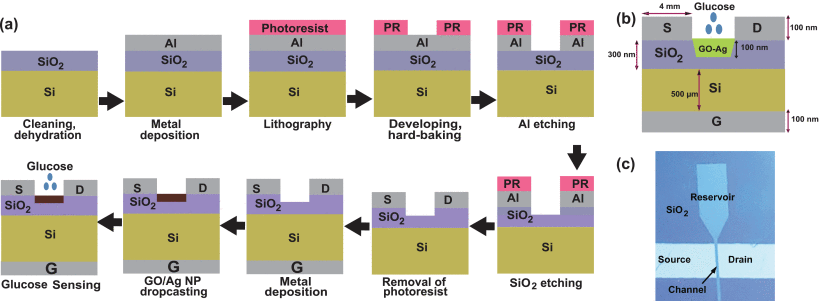Non-Enzymatic Glucose Detection Based on GO/Ag Nanocomposite in SiO2 Trench Embedded Field Effect Transistor
Accurate glucose monitoring is crucial for preventing diabetes complications, considering the global diabetes issue is expected to affect millions of people by 2025, posing risks to nerves, blood vessels, and multiple organs. Diabetes results from insufficient insulin levels, causing difficulty in managing blood sugar. A reliable method for precise glucose detection is necessary for clinical diagnostics and patient monitoring.
Field-effect transistors (FETs) with diverse nanostructures are a stable alternative, regarded for their high sensitivity and real-time monitoring capabilities. This study focuses on SiO2 trench-embedded FETs using a GO/Ag nanocomposite for non-enzymatic glucose detection, aimed at creating a high-performance sensor with a simple synthetic process.
The nanocomposite, incorporating Ag-NPs as a conductive channel, enhances conductivity and sensing capabilities. Material characterization assesses the GO/Ag nanocomposite's structure and morphology, positively evaluating its reaction strength to varying glucose levels, sensitivity, and detection limit. The SiO2 trench and reservoir design eliminate the need for an additional well and streamline the pouring of the analyte.
Experimentation involves various chemicals and materials, such as Graphite powder, Sodium nitrate, and Potassium permanganate with D-glucose as the base and Milli-Q Grade water. The modified Hummers method produces GO, while the GO/Ag nanohybrid is prepared through a manual deposition method. Device fabrication on n-type <100> oriented silicon wafers with a 300 nm SiO2 layer incorporates a trench structure, preventing overflow and enhancing gate control.
Raman analysis of the sensor reveals improved structural characteristics in the GO/Ag nanocomposite, while Fourier-transform infrared spectroscopy (FTIR) highlights its chemical composition. Field emission scanning electron microscopy (FESEM) images depict well-organized Ag nanoparticles on GO sheets. The X-ray diffraction test confirms the crystalline state of the produced GO and GO–AgNP nanohybrid.
Electrical testing employs a DC probe station, 2450 source meter, and power supply. The investigation of using the GO/Ag nanocomposite as a conductive channel material demonstrates enhanced sensing current compared to GO alone. The fabricated device exhibits increased sensitivity across the glucose concentration range of 1 μM to 10 mM, promising early-stage diabetes detection capabilities.
The real-time response of the fabricated n-type FET sensor at Vg = 3 and Vd = 4.5 V shows sensitive responses to 1 μM glucose with a signal-to-noise ratio of 3.5. High specificity for glucose is confirmed through sensitivity analysis, distinguishing it from other molecules. Repeatability across fabrications shows a minimal batch-to-batch variation (<±2% of the mean reading), and stability tests over 30 days demonstrate consistent responses.
The sensing layer, combining GO and Ag NPs, exhibits a high level of oxygen interaction and catalytic activity. The sensing mechanism involves glucose transformation to D-glucono-1,5-lactone and H2O2, with subsequent release of oxygen atoms adsorbed onto the GO/Ag nanocomposite. These strong interactions result in increased electrical signal changes.
In conclusion, this SiO2 trench FET-based sensor utilizing a GO/Ag nanocomposite showcases exceptional attributes, including high sensitivity, stability, rapid response time, and an impressive detection limit. The inclusion of a trench structure aids in liquid storage, also enhancing sensing capabilities, marking a promising advancement in glucose sensing technology.




